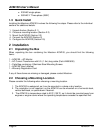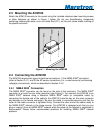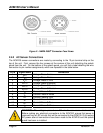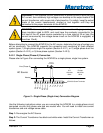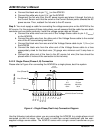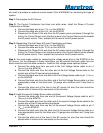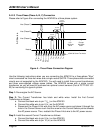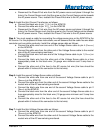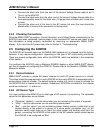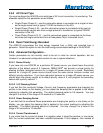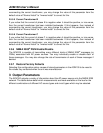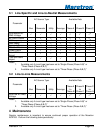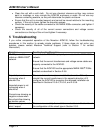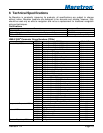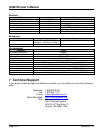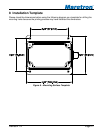
ACM100 User’s Manual
Page 10 Revision 1.2
c. Connect the black wire from one end of the second Voltage Sense cable to pin 3
(V
CLine
) on the ACM100
d. Connect the black wire from the other end of the second Voltage Sense cable to a
fuse appropriately sized for the black wire (18 gauge wire minimum and 3 amp fuse
or less).
e. Connect the other end of the fuse to the AC source hot wire (the fuse should be
placed within 6 inches of the connection to the hot wire).
2.4.3 Checking Connections
Once the NMEA 2000
®
connection, Current Sensor(s), and Voltage Sense connection(s) to the
ACM100 have been completed, restore power to the monitored AC source and check to see
that information is being properly transmitted by observing an appropriate NMEA 2000
®
display. If you don’t see AC power data, refer to Section 5, “Troubleshooting”.
2.5 Configuring the ACM100
The ACM100 will transmit data over the NMEA 2000 network as it is shipped from the factory;
however, it may require configuration, depending on the type of AC source being monitored.
There are several configurable items within the ACM100, which are detailed in the remainder
of this section.
You configure the ACM100 using a Maretron DSM250 display or other NMEA 2000
®
display
unit that is capable of configuring the ACM100. Please refer to the Maretron DSM250 User’s
Manual for details.
2.5.1 Device Instance
NMEA 2000
®
provides a unique AC power instance for each AC power source on a vessel.
This value should be programmed in each ACM100 so that each ACM100 is associated with a
unique device instance number. The default instance number is 0, which is used to indicate the
first ACM100 that is hooked to the network. Subsequent ACM100s connected to the network
would be numbered 1, 2, and so on.
2.5.2 AC Device Type
You must configure the ACM100 as to what type of AC source it is monitoring. The allowable
values for this parameter are as follows:
• “Generator” (default) – use this value when you are monitoring the output of a genset.
• “Utility” – use this value when you are monitoring shore power
• “Bus” – use this value if you are monitoring power flowing across a cable that is not
located directly at the output of a genset or a shore power connection (e.g., an AC
selection switch might have as an input the shore power and another input from the
genset, connecting the ACM100 at the output of the AC selection switch would require
the ACM100 to be configured as “Bus”.



